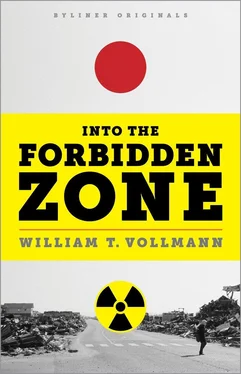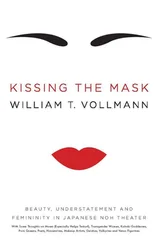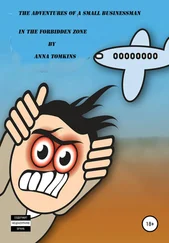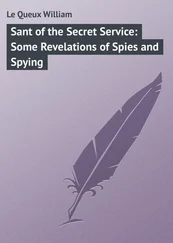William T. Vollmann
Into the Forbidden Zone: A Trip Through Hell and High Water in Post-Earthquake Japan
I: PICARESQUE WANDERINGS OF A DOSIMETER

THE GOLDEN RULE OF JOURNALISM — keep one’s dental appointments — I had now neglected for a couple of years, but in obedience to the current practicalities of Japan I made haste to cultivate my hygienist, who pressed the X-ray camera’s snout against patients’ cheekbones and therefore wore a dosimeter badge clipped to her pinkish smock. Thanks to her, I grew acquainted with the phone number of Carol (on subsequent dialings I got Ginger), who connected me with a salesman named Bob, who allowed that he did still have one Geiger counter in stock — or, more precisely, a post — Geiger-Müller sort of gadget which, said Bob (who had not actually inspected it but seemed to be interpolating from some data screen), resembled an electronic calculator. Current and cumulative exposure, X-ray and gamma, a programmable exposure alarm — oh, delicious! Never mind its inability to detect alpha or beta particles; wouldn’t those be approximately innocuous so long as I refrained from ingesting them? (Within the body, remarked my radiation incident guide, “alpha and beta emitters are the most hazardous” since they “can transfer ionizing radiation to surrounding tissue, damaging DNA or other cellular material.”) 1
Five hundred dollars plus shipping, credit card only; thus spake Bob, who must have known he was sitting pretty, for the other companies I had contacted accepted only back orders, two weeks having already lapsed since the reactor accident. In Japan, so I heard, one couldn’t buy dosimeters at all. I wondered aloud whether Bob’s product came with a probe to stick into my sashimi, because that, I proposed, might be fun. Eliding the issue of fun, Bob (who informed me that he had had a long, hard week) assured me that I could hold the machine six inches away from, say, a glass of drinking water, after which I would really know something. Potable water being unavailable in much of the disaster area, and Tokyo’s water supply having been spiced up with variable radioactivity, I considered myself canny to have pounced upon this capacity for pinpoint monitoring.
At this point in our transaction, any self-respecting used car buyer would have kicked a tire while nodding wisely; I accomplished the equivalent by asking which units of measurement the thing employed. Millisieverts and millirems, replied Bob. I confess that this answer left me feeling long in the tooth, for in my day it had all been roentgens. When I phoned my friend the retired radiologist, he came down solidly in my camp, announcing: “I’m too old to care about millisieverts.” Vaguely remembering from my university education that four hundred roentgens was a lethal dose, I dusted off my copy of Physical Chemistry (1966), wherein I learned that “the development of the nuclear reactor, which promises to be a very important power source, has led to many challenging chemical problems.” 2That’s nice. Actually, “a lethal whole-body single dose of radiation for man is about 500 roentgens”; 3now it was all coming back, except that I’d better learn how to convert to sieverts.
My lean old Swedish neighbor offered to lend me his Geiger counter, a souvenir of business dealings in the Jewish Autonomous Oblast of the Soviet Union, but I could not guarantee my ability to return it. At my request, he took a reading right there in my parking lot, a good ten days after the Japanese radioactive plume had officially reached our city. The dial slept at zero. Well, hadn’t the newspaper promised us that the levels were practically undetectable? Sighing, my neighbor wondered whether his toy was still calibrated. He slipped it back into the worn leather case, and because I could see that he loved it very much, I knew I had done right to leave it in his keeping.
My new dosimeter (whose brand and model number I decline to insert here unless the manufacturer pays me) did indeed resemble a calculator. It was a fat, blue, boring little plastic thing with a pocket clip. After an hour or so I figured out how to turn it on. And what do you know? The number in the narrow window was zero. How could I ascertain whether it even functioned? To be sure, a hand-signed certificate of calibration came enclosed; and the background radiation in Sacramento ought to be negligible even now, so the fact that the window displayed zero and only zero was no cause for suspicion; all the same, I preferred not to trust my life to a calibration certificate.
Hence another kindhearted neighbor, who had connections in the local fire department, carried into my living room a padded envelope hand-labeled DANGER — RADIATION. My twelve-year-old grimaced in horror; she preferred to stay in the kitchen. Out came a plastic box containing a radioactive point source of unknown magnitude, which my neighbor’s bare hand now conveyed from her side of the sofa to mine. My neighbor assured me that the source was weak, and likewise her surprise bonus: one of her Great Aunt Lou’s orange-glazed dinner plates, which had become a rarity as soon as our government sequestered that orange glaze for the Manhattan Project. I clinked my dosimeter against the point source and the plate, each for a good five seconds, and the display continued steady at zero. In due course I would realize that Bob had misrepresented the machine’s capabilities; all it could read, except in extreme cases, was incident radiation, which is like the ambient radiation all around you, like the air. I would have to take the safety of Tokyo’s drinking water on faith. I sat glumly beside my neighbor, wondering whether my toy had arrived broken, and imagining that my leg was receiving a radiation sunburn. Why wouldn’t she at least move that plate away?
I left my dosimeter at my bedside in measurement mode all night, and in the morning it was still at zero. But then the Radiation Gods saw fit to bestow upon me a sign. Since my best friend’s brain tumor had begun to grow again (or perhaps wasn’t growing at all, depending on which doctors said what), it came time for his gamma knife surgery. His wife and I accompanied him to the cyber-knife chamber while he got strapped down. Then we returned to the waiting room to worry about him. During that ten-minute interval, the dosimeter registered 0.1 millirems. Did that mean that there was stray radiation around here, or simply that the dosimeter reported in 0.1 millirem increments? Either way, life was looking up. I decided to forget millisieverts and dwell in millirems.
My radiation incident guide (a present from the neighbor with the orange plate) informed me that 0.05 millirems or less per hour falls within the bounds of normal background exposure, while even 0.1 millirems can be considered unexceptional; indeed, the average dose (in the United States, I assume) is 360 millirems per year — a figure I find shockingly high, since 365 days of 0.1 millirems would give only 36.5 millirems. Doubtless our author threw in a few chest X-rays, airplane rides, and slumber parties in stone castles full of radon gas. A reading above 0.1 millirems per hour, I learned, is worrisome. 4Worried I was not, since my readings in San Francisco and Sacramento were on the order of 0.1 millirems per day.
The radiation incident guide advised me that if I were a “responder” of the best official type I ought to limit my dose at any one occasion to 5 rems; hence that would be my ceiling for Japan. Five rems divided by ten days would be 500 millirems a day, or five thousand times what I was getting in San Francisco. According to the U.S. Environmental Protection Agency, certain mild symptoms may appear at 30 rems. Radiation sickness manifests itself at 70 to 100 rems. Above 350 rems, any recovery is likely to be followed by a relapse. Two hundred fifty to 500 rems is the lethal dose for 50 percent of humans within sixty days. (Do rems sound a trifle like roentgens? Well, “rem” is an abbreviation for “roentgen equivalent man.”) At 5,000 rems (or, if you like, 50 sieverts), all patients die within forty-eight hours. 5
Читать дальше













